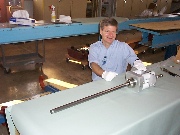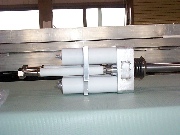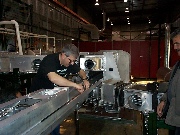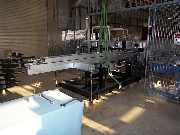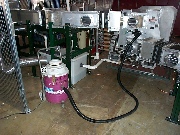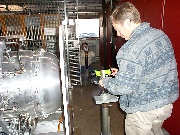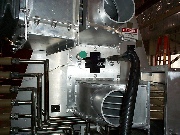Assembly of the Beryllium Target on 2/07/02At this point the horn has been tested to 1E7 pulses (no radiation yet) and has survived without any sign of degradation. This page shows the assembly and installation of the final beryllium target into the horn for its first tests with air flow and pulsing. This was also the first time we tried to use the six strut target support frame to transfer the target from outside the horn box to inside. This was a mixed bag as we discovered a few things that needed to be changed about this target support structure. Click on any of the thumbnails to get an enlarged view. You are welcome to download any of the images. If they are used for other than private viewing, credit to Bartoszek Engineering would be appreciated.
Bench assembly of the final beryllium target module After an arduous manufacturing "journey of discovery" at Los Alamos, the beryllium target for MiniBooNE is finally at FNAL. The middle photo shows the last target slug with its cooling fins at the downstream end of the beryllium tube. The right photo shows all the ceramics necessary to isolate the voltage of the target from the horn box.
First test of the six-strut target support frame The six strut frame demonstrated that it was easy to align, however there was a few mil interference that prevented the rails in the horn box from lining up exactly with the rails on the external frame. This will be corrected shortly. This frame is the only way to assemble new target and BPM modules to the horn box once it is installed at MI-12. It has all six degrees of freedom of alignment from a set of custom precision turnbuckles.
Testing for air flow induced vibrations in the target The final target cooling system will not be ready for about two months, but we wanted to test the effect of the target air flow on target and horn inner conductor vibrations. The tox-vac shown has a HEPA filter that allows us to suck air through the beryllium target at about the same rate as the real blowers for the system, and it can catch any fine particulates that may still be within the target tubing. We will run the horn and the vacuum to see whether the vibrations due to air flow and those from the pulsing interact in any way. The suction at the downstream end of the horn was truly impressive in this set up.
Setting up the telescope to view the target The horn pulses inside a cage to prevent high voltage exposure to people, so we have to view the target inside the horn by looking through a telescope pointed at a mirror right in front of the horn. This scope allows us to view any transverse motion of the horn inner conductor or target. With the tox-vac running, small oscillations of the target slugs were seen. We will videotape the image in the telescope to fix the viewing frame of reference. By eye, it is hard to tell if the outer tube of the target moves significantly when the air is running.
View of the upstream end of the horn box as of 2-7-02 This photo shows that the air cowlings are assembled around the upstream end of the striplines, and the target flange is bolted on fixing the target module to the horn box. Back to the MiniBooNE Horn Main Menu Back to the Bartoszek Engineering Home Page |
